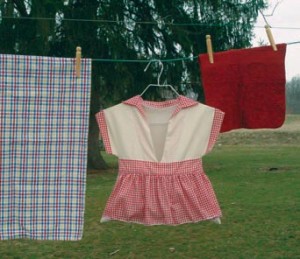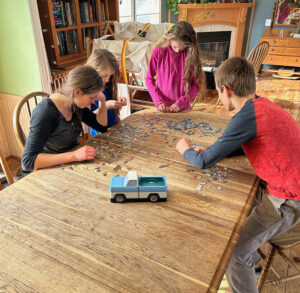Gardening has the reputation of being a fairly solitary activity. It has been said it is more addictive than heroin.  Some people view it as “nature’s Prozac,” since being outdoors ups our serotonin levels and the activity gets those endorphins going. But gardening is also great as a community building activity, too.
Some people view it as “nature’s Prozac,” since being outdoors ups our serotonin levels and the activity gets those endorphins going. But gardening is also great as a community building activity, too.
Yesterday we had what we call our Seed Collective meeting at our home.
There are six of us living within the same mile radius. We came to the realisation that some had success with plants that languished for others. We all have fairly acidic soil, but whereas Tony and I have a high ratio of peat, Cliff has clay that is more suitable to starting a pottery. We also had to pay the price of success by dealing with gluts. So we have decided to club our expertise and vegetables. This way we can share out gluts. Since some of us get results earlier than others we realised that nature staggers our produce so we are in effect reaping the benefits of successional sowing without having to do it ourselves. William has a polytunnel high up on a hill so he gets results early. Meanwhile, Tony and I are in a frost pocket. The upside of this is that we can still be picking courgettes in our polytunnel in October.
There were seven of us for a lunchtime meeting where we swap around old seed leftover from last season. We also discuss what seed varieties worked for us. Even though we all live within six miles from one another we all have very different types of ground and levels of experience. Our friend with the heavy clay is working on making compost. In the meanwhile, he has a conservatory and this means he has scope for bringing on more exotic plants. William is busy this year so he is offering up some space in his polytunnel for communal tomato growing. Andy has long experience growing outside. Tony is putting in trees on our acre. Isabella and I swap herbs.
Since I have been mildly (gardening) disabled since an ankle break last summer my own prime gardening talent – propagation – is still valuable to the group. I agree to bring on the seedlings and then pass them on to others like a baton in a relay race. Each of us has something to offer whether we are novices or old hands.
We discuss the blight resistant merits of various spud varieties. Since the majority of the ‘collective’ are vegetarian this year we are going to try two seed varieties of beans for drying. So ensued a discussion on us all jointly purchasing a drying machine for using on soft fruits, apples as well as the beans.
We pass around various catalogues for perusal. Discussion gets animated but various members start to make lists of seeds that we will order, buy together and share out. Every so often Tony will shout out, “Have we finished talking about Peas and Beans? (Or tomatoes, etc.) Okay, what’s next?â€
I announce that I have had it with the leatherjackets and this year I am declaring biological (and completely organic) warfare in the polytunnel with nematodes. We narrowly avert a deeper discussion on pacifism in the garden that would have taken on theological dimensions with a call for lunch.
Which in the household means homemade soup, bread or scones and then some sort of cake.
Now if you are really going to be a collective you could go the ‘Stone Soup’ route based on the folk tale. We have done this with a storytelling group. You agree to bring a particular colour vegetable – white, yellow, orange, red or green. Then as you discuss the business to hand you peel and chop your ingredients and pop them in the pot. By the time you have got to the end of your agenda you have a tasty lunch made.
Yesterday, however, we had a lot of people in a very small cottage space so I did the cooking. In honour of the brightening days I declared it time for Spring Sunshine Soup.
You will need a 2-litre soup pot.
You will fill it ¾ full of vegetables, which break down roughly as follows:
Sauté 3 onions in a generous knob of butter over a low heat.
Roughly chop and add:
1 cup of celery
3 parsnips
3 sweet potatoes
6 medium carrots
Finely snip 2 inches of dried wakame seaweed (optional).
Stir the vegetables so they are coated with some of the butter. Season with pepper and organic mixed spice to taste (1-2 tsp). DO NOT ADD SALT!
Add 1 cup of red split lentils.
Pour 1.7 litres of water over veggies. Add vegetable stock – 2 cubes or 2 TBSP of powdered.
Simmer for an hour or so. Cool and liquidise. Gently reheat before serving.
For dessert I figured it was time to use up the last bits of rhubarb in the freezer.
Rhubarb Ginger Cake with Orange Glaze
Prepare a rectangular tin by buttering it and dusting with flour.
Preheat the oven to 375F/190C
Melt 200g butter.
Cream in 1 cup of sugar.
Beat in 3 medium eggs.
Grate in the rind of 1 orange. (Juice it and put to one side for the glaze) Grate in 1 inch of ginger root – alternatively 2 tsps ground ginger. Sieve in 2 cups of self-raising flour and combine. Fold in 2 cups of rhubarb that is blanched and cut into ½ inch cubes.
Bake at 350 degrees for 40-50 minutes, depending on your oven.
For the Orange Glaze:
Take the reserved juice, which may be about 100-ml/4 fl.oz. Sieve in 3 tsp cornstarch.
Gradually sieve in confectionary sugar, 4-6 TBSP. What you are aiming for is a slightly thickened liquid the colour of a boiled egg yolk.
Since the juice of one orange will vary (and I hate waste) you need to add it a spoon at a time. The colour of the glaze is the best test that you are on the right track.
When the cake is golden and a skewer in the middle comes out clean, take it out of the oven. Leave it in its tin and cool slightly (about 5 minutes) before pouring the glaze over the cake.


































I feel so slose to God in the garden, as I pick vegetables and hear the birds and the honeybees and wasps buzzing around. It is so obvious then how He provides it all.